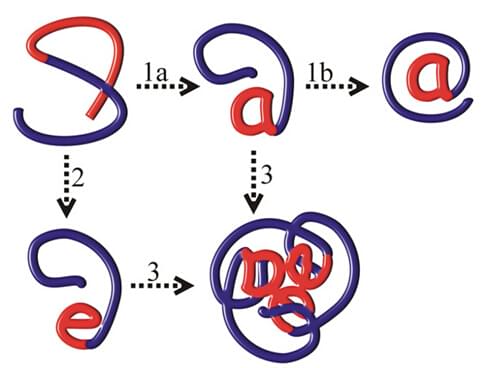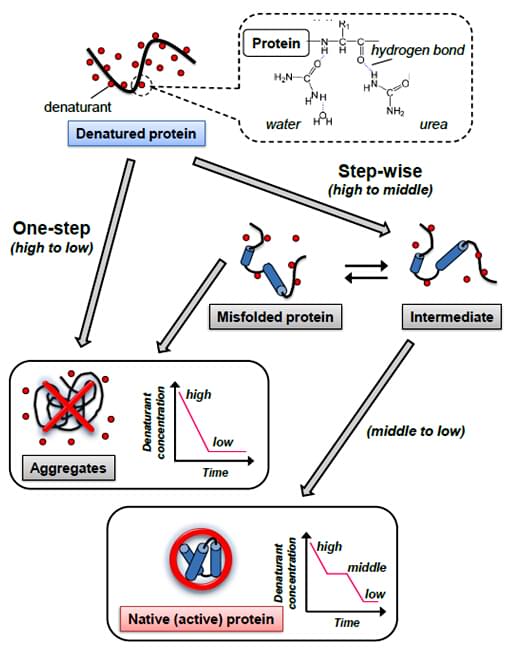Our Products Cannot Be Used As Medicines Directly For Personal Use.


Welcome! For price inquiries, please feel free to contact us through the form on the left side. We will get back to you as soon as possible.
Enzyme Recovery and Refolding
Creative Enzymes is a leader in development, manufacturing, and testing of numerous enzymes. Many advanced enzyme expression and, especially, customer-oriented enzyme purification services are available for all industrial and academic customers. We provide completely tailor-made services for purification of the target enzymes. Post-purification recovery and refolding is one of the unique services of Creative Enzymes, which is an important part of purification that could greatly improve the overall expression yield.
Recombinant enzyme expression technology is widely used. Heterologous gene expression commonly leads to production of inclusion bodies. Refolding of enzymes to native conformation from a denatured state, such as in inclusion bodies, is a limiting step during recovery of active enzymes. Enzyme aggregation is a common occurrence resulting in low recovery rates. Creative Enzymes uses several techniques to achieve correct refolding:
- Direct dilution
The simplest enzyme refolding method is to dilute the concentrated enzyme-denaturant solution into a refolding buffer that allows the formation of the enzyme native structure. Though ideal at laboratory scale, this method has serious disadvantages during scale-up as huge refolding vessels and additional cost-intensive concentration steps are required after renaturation.
 Figure 1: Simplified model of correct folding versus misfolding and aggregation. The correct enzyme folding pathway (shown as 1) often competes with misfolding (shown as 2) and aggregation (shown as 3). Blue lines stand for the hydrophilic solvent-exposed parts of the protein; red lines stand for the hydrophobic patches.
Figure 1: Simplified model of correct folding versus misfolding and aggregation. The correct enzyme folding pathway (shown as 1) often competes with misfolding (shown as 2) and aggregation (shown as 3). Blue lines stand for the hydrophilic solvent-exposed parts of the protein; red lines stand for the hydrophobic patches.
Reference: Vallejo F L, Rinas U. Microbial Cell Factories, 2004, 3(1):1-12.
- Dialysis
In dialysis, the chemically denatured enzyme is refolded to sufficiently decrease the denaturant concentration and allow enzyme refolding. One-step dialysis is easy to operate. The method is, however, sometimes not suitable for large-scale operations.
 Figure 2: Schematic illustration of the two types of dialysis method for the removal of denaturants from denatured protein solutions. In one-step dialysis, the denaturant concentration around the protein rapidly decreases through diffusion, leading to aggregates. In step-wise dialysis, gradual removal of denaturant from the denatured proteins occurs.
Figure 2: Schematic illustration of the two types of dialysis method for the removal of denaturants from denatured protein solutions. In one-step dialysis, the denaturant concentration around the protein rapidly decreases through diffusion, leading to aggregates. In step-wise dialysis, gradual removal of denaturant from the denatured proteins occurs.
Reference: Yamaguchi H, Miyazaki M. Biomolecules, 2014, 4(1):235-251.
- Chromatographic Methods for Enzyme Refolding
a. Adsorption chromatography (SEC, HIC, IEC, IMAC)
The adsorption of denatured enzyme on a medium can effectively inhibit non-specific interactions between enzyme molecules to improve enzyme refolding rate. This method is high efficiency, time-saving, and recyclable.
b. Gel filtration chromatography
Molecular sieve effect can separate the enzymes and small molecules denaturant, achieving solution exchange and enzyme refolding. This method achieves one-step automated enzyme refolding and purification.
c. Chromatography refolding mediated by immobilized chaperone / foldase
Immobilized chaperone or foldase on medium makes the chromatographic column a folding reactor.
- Micelles and Liposomes as Enzyme Refolding Aiding Systems
Detergents and phospholipids, in the form of micelles and liposomes, respectively, have shown potential to aid protein refolding. Enzyme molecules can be wrapped in reverse micelle, reducing the aggregation in the process of enzyme folding, and through gradually reducing the concentration of the denaturant and joining the REDOX, denatured enzymes refold.
- Aqueous Two-Phase Systems (ATPS)
Aqueous two-phase systems (ATPS) have earlier been successfully used for the recovery of active enzymes. ATPS makes the dissolution of inclusion bodies and enzyme refolding completed in one step.
- Refolding by High Hydrostatic Pressure
High pressure can solubilize aggregates while favoring the native enzyme conformation. This method has many advantages: performing solubilization and enzyme refolding simultaneously; independent of enzyme concentration; disaggregating and refolding enzymes rapidly.
Recovering biologically active enzymes is the important goal in enzyme, not only for analysis of the enzyme structure and function, but also for the development of therapeutic drugs and industrial processes. However, there is no universal refolding recipe for any enzyme, because enzyme folding can be affected by various physiochemical parameters including ionic strength, pH, temperature, oxidation state, and enzyme concentration, as well as the presence of hydrophobic, polar, chaotropic agents and other proteins. For any given enzyme, the perfect refolding conditions still need to be determined individually. Creative Enzymes has extensive experiences to solve challenges of enzyme refolding. Through our state-of-the-art facilities and industry-leading technical expertise, we offer the innovative and bespoke enzyme recovery and refolding services to customers.